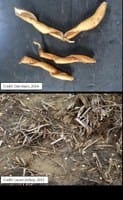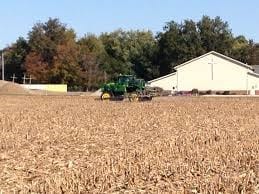Hello,
Friday we were able to harvest the corn population test plot. The combine yield monitor measured 201-225 bushels per acre with a moisture range of 20-22%. The test weight was between 55-56 pounds per bushel. We had six different seed populations repeated four times across the 40 acre plot. I haven’t had a chance to look at all of the data yet, but was able to pull ears from each test strip in half of the plot. I would like to thank Paul Ralston for cooperating with the test plot as part of our Hardin County OSU Extension on-farm research. I will share the data after I have had a chance to put everything together.
Soybean harvest is on again, off again with the rains. It seemed like it rained about a tenth of an inch each day with three to four tenths this past Tuesday, enough to slow down those who were trying to get work done in the fields. I have attached the Extension rainfall report for September. We are 2.79 inches behind with our growing season rainfall when you compare our normal ten year average. Between now and Thanksgiving, some will be applying fall burn down herbicides to help control problem weeds. One of the weeds recently discovered somewhat close to us in Putnam County is Palmer Amaranth. Read the attached article written by Ed Lentz for more information about this new resistant.
This past weekend I attended the State Master Gardener Volunteer Conference in Delaware. Our nomination of Mid-Ohio Energy Cooperative was selected as a state winner for the Friend of Master Gardener Volunteers award and our own Dave McPheron was named one of 5 Outstanding Master Gardener Volunteers in the state of Ohio. He was also a state finalist for Outstanding Master Gardener Volunteer Coordinator. Additionally, our county MGV group was recognized for being a state Gold Standards of Excellence winner.
Saturday and Sunday, October 25-26 will be our Hardin County Sheep Management Tour of central and eastern Ohio. 20 area sheep producers and others will be participating in this annual tour. Don’t forget to order your Dairy Service Unit Cheese by October 31. I have attached an order form in case you still want to send in an order. Below are some articles that you might be interested in reading.
Mark
Frosted Forage Precautions – Mark Sulc
Jack Frost will be visiting us soon. Several forage species can be extremely toxic soon after a frost because they contain compounds called cyanogenic glucosides that are converted quickly to prussic acid (i.e. hydrogen cyanide) in freeze-damaged plant tissues. Others species have an increased risk of causing bloat when grazed after a frost. Go to http://corn.osu.edu/newsletters/2014/2014-35/frosted-forage-precautions to read about these forages.
Soybean Pod Shattering – Laura Lindsey
Soybean pod shattering is not completely understood. Through breeding efforts (beginning approximately 5,000 years ago when soybean was first thought to be domesticated), soybean plants have gained pod shattering resistance (Dong et al., 2014). However, certain environmental conditions can lead to pod shattering. Go to http://corn.osu.edu/newsletters/2014/2014-35/soybean-pod-shattering to read more about soybean pod shattering.
Does Black Layer Form When Corn Is Frosted? – Peter Thomison
Black layer is the stage in corn development at which kernel growth ceases and maximum kernel dry weight is achieved (also referred to as “physiological maturity”). A killing fall frost prior to physiological maturity can cause premature leaf death or whole plant death. This occurred over the weekend when temperatures dropped below freezing in some late planted Ohio corn that had yet “black-layered”. Go to http://corn.osu.edu/newsletters/2014/2014-35/does-black-layer-form-when-corn-is-frosted to finish reading this article.
Five Things to Know about Fall Herbicide Treatments – Mark Loux
There is plenty of information on fall herbicide treatments in the C.O.R.N. newsletter archive and on other university websites. Our philosophy on this has not changed much over the past decade. A few brief reminders follow: When to spray? Anytime between now and Thanksgiving will work, and possibly later. We have applied into late December and still eventually controlled the weeds present at time of application. Go to http://corn.osu.edu/newsletters/2014/2014-35/five-things-to-know-about-fall-herbicide-treatments to finish reading this article.
Prussic Acid Testing in Forages – Mark Sulc
Some forage species can develop prussic acid poisoning potential when harmed by frost and management practices should be followed to prevent poisoning of livestock (see accompanying article). If doubt remains regarding the safety of the forage, it can be tested for prussic acid (cyanide) content. Go to http://corn.osu.edu/newsletters/2014/2014-35/prussic-acid-testing-in-forages to learn more about Prussic Acid testing for forages.
Mark A. Badertscher
Agriculture and Natural Resources Educator
OSU Extension Hardin County
1021 W. Lima Street, Suite 103, Kenton, OH 43326
419-674-2297 Office





